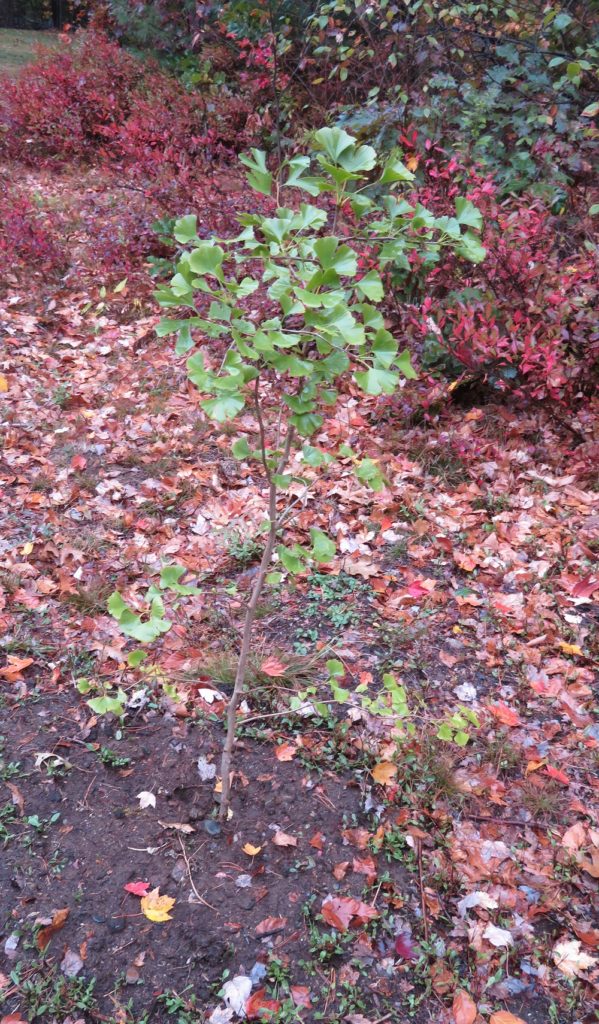
I planted a tree last week. Why? A couple of weeks ago, I got a medicinal Ginkgo tree as a present from students. Fall is a great time to start shrubs and trees. We planted the tree in a special place in our yard. When my husband and I transplanted this beautiful gift, it felt so right.
It warmed my heart and thrilled me to get a tree as a gift. Wow, my students understood that I would love a tree as a present. I was thrilled because I want a Ginkgo Tree in my yard. Now I have one! Planting a tree is an act of hope in these confusing times. Hope is something to hang onto as the COVID 19 pandemic continues, and the presidential election approaches.
Trees are an essential element in my environment. My house hosts a couple of trees and my yard many more. Being in nature, even looking at plants and trees, is sattvic. My writing desk view offers me the opportunity to look up and see trees all year long. I feel that planting a tree is a symbol of hopefulness for the future.
“When we plant trees, we plant the seeds of peace and seeds of hope.”
Wangari Maathai
Helping Trees
Trees held and nourished our planet long before we populated the earth. The roots or the brains of the trees are instrumental in creating the soil. The leaves the energy factories reach to the sun convert and store energy, then fall to the earth to feed it. The great forests of this planet create an environment filled with life and liveliness. Humanity has been very hard on the trees, and we need to wake up. Forests occupy 30% of the ground and host 80% of the life on land.
Gifting A Tree
A tree is a living thing, and gifting living entities conveys responsibility to promote their lives and well-being. People who know me understand that I love plants, herbs, and trees, so I often get a pot or two to transplant. We planted the tree, and I am watering it in to overwinter. Next spring, we will see how well we set this tree up in its new living quarters.
Why plant Trees?
Planting trees build healthy wildlife habitat, improves water and air quality, picking up CO2, and gifting O2. The colors and pheromones of trees help us to relax and feel safe. In Ayurveda, trees and plants are medicine. Cultivating plants and herbal medicine is part of seasonal routines. Each year I spend time growing and preparing plants for nutritional and medicinal properties to help my family and me.
I know the medicinal properties of Gingko Biloba well, we have used it for years, but growing it will be a different kind of learning. Many plants have special needs, and learning how to grow, harvest, and garner seeds is a journey alongside each plant.
Ginkgo Biloba
Gingko trees can live over one thousand years. They have been on our planet for millennia. An old species, these trees have great beauty and are planted as an ornamental just for their good looks.
The most commonly used medicinal parts of ginkgo are the leaves. Gather the leaves late in the season just before or as they change color to yellow for the highest potency. Make a tincture to deliver the ginkgolides and other actives or buy one from a reputable herbalist.
Gingko Biloba supplements build improved circulation, including hands, feet, brains, and eyes. Active components help calm inflammation pathways. My husband and I take it to maintain a healthy memory and brain processing. Ongoing research has discovered many potential health benefits; for more information on this plant, check here.

Think about it before you gift a tree. If the recipient doesn’t have the land or can’t take care of it, Find another way. You can give trees as presents through several organizations that work on repopulating forests. Then take the recipient out in nature to celebrate the gift.
Ayurselfcare’s purpose is to educate on the benefits of Ayurveda. This article is not a substitute for professional medical care, treatment, or advice. All the material here is for learning purposes only. Always share strategy and work with your health care team.
